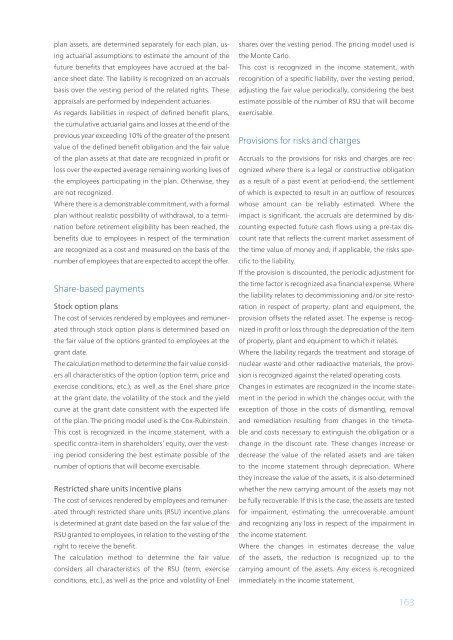Annual Report 2010 - Enel.com
Annual Report 2010 - Enel.com
Annual Report 2010 - Enel.com
You also want an ePaper? Increase the reach of your titles
YUMPU automatically turns print PDFs into web optimized ePapers that Google loves.
plan assets, are determined separately for each plan, using<br />
actuarial assumptions to estimate the amount of the<br />
future benefits that employees have accrued at the balance<br />
sheet date. The liability is recognized on an accruals<br />
basis over the vesting period of the related rights. These<br />
appraisals are performed by independent actuaries.<br />
As regards liabilities in respect of defined benefit plans,<br />
the cumulative actuarial gains and losses at the end of the<br />
previous year exceeding 10% of the greater of the present<br />
value of the defined benefit obligation and the fair value<br />
of the plan assets at that date are recognized in profit or<br />
loss over the expected average remaining working lives of<br />
the employees participating in the plan. Otherwise, they<br />
are not recognized.<br />
Where there is a demonstrable <strong>com</strong>mitment, with a formal<br />
plan without realistic possibility of withdrawal, to a termination<br />
before retirement eligibility has been reached, the<br />
benefits due to employees in respect of the termination<br />
are recognized as a cost and measured on the basis of the<br />
number of employees that are expected to accept the offer.<br />
Share-based payments<br />
Stock option plans<br />
The cost of services rendered by employees and remunerated<br />
through stock option plans is determined based on<br />
the fair value of the options granted to employees at the<br />
grant date.<br />
The calculation method to determine the fair value considers<br />
all characteristics of the option (option term, price and<br />
exercise conditions, etc.), as well as the <strong>Enel</strong> share price<br />
at the grant date, the volatility of the stock and the yield<br />
curve at the grant date consistent with the expected life<br />
of the plan. The pricing model used is the Cox-Rubinstein.<br />
This cost is recognized in the in<strong>com</strong>e statement, with a<br />
specific contra-item in shareholders’ equity, over the vesting<br />
period considering the best estimate possible of the<br />
number of options that will be<strong>com</strong>e exercisable.<br />
Restricted share units incentive plans<br />
The cost of services rendered by employees and remunerated<br />
through restricted share units (RSU) incentive plans<br />
is determined at grant date based on the fair value of the<br />
RSU granted to employees, in relation to the vesting of the<br />
right to receive the benefit.<br />
The calculation method to determine the fair value<br />
considers all characteristics of the RSU (term, exercise<br />
conditions, etc.), as well as the price and volatility of <strong>Enel</strong><br />
shares over the vesting period. The pricing model used is<br />
the Monte Carlo.<br />
This cost is recognized in the in<strong>com</strong>e statement, with<br />
recognition of a specific liability, over the vesting period,<br />
adjusting the fair value periodically, considering the best<br />
estimate possible of the number of RSU that will be<strong>com</strong>e<br />
exercisable.<br />
Provisions for risks and charges<br />
Accruals to the provisions for risks and charges are recognized<br />
where there is a legal or constructive obligation<br />
as a result of a past event at period-end, the settlement<br />
of which is expected to result in an outflow of resources<br />
whose amount can be reliably estimated. Where the<br />
impact is significant, the accruals are determined by discounting<br />
expected future cash flows using a pre-tax discount<br />
rate that reflects the current market assessment of<br />
the time value of money and, if applicable, the risks specific<br />
to the liability.<br />
If the provision is discounted, the periodic adjustment for<br />
the time factor is recognized as a financial expense. Where<br />
the liability relates to de<strong>com</strong>missioning and/or site restoration<br />
in respect of property, plant and equipment, the<br />
provision offsets the related asset. The expense is recognized<br />
in profit or loss through the depreciation of the item<br />
of property, plant and equipment to which it relates.<br />
Where the liability regards the treatment and storage of<br />
nuclear waste and other radioactive materials, the provision<br />
is recognized against the related operating costs.<br />
Changes in estimates are recognized in the in<strong>com</strong>e statement<br />
in the period in which the changes occur, with the<br />
exception of those in the costs of dismantling, removal<br />
and remediation resulting from changes in the timetable<br />
and costs necessary to extinguish the obligation or a<br />
change in the discount rate. These changes increase or<br />
decrease the value of the related assets and are taken<br />
to the in<strong>com</strong>e statement through depreciation. Where<br />
they increase the value of the assets, it is also determined<br />
whether the new carrying amount of the assets may not<br />
be fully recoverable. If this is the case, the assets are tested<br />
for impairment, estimating the unrecoverable amount<br />
and recognizing any loss in respect of the impairment in<br />
the in<strong>com</strong>e statement.<br />
Where the changes in estimates decrease the value<br />
of the assets, the reduction is recognized up to the<br />
carrying amount of the assets. Any excess is recognized<br />
immediately in the in<strong>com</strong>e statement.<br />
163









